Age of Empires II: The Conquerors Preview
Elliott Chin takes a look at the gold build of Age II: The Conquerors and offers some strategy tips.
Age of Empires II: The Conquerors is nearly finished, and it should arrive on store shelves at the end of this month. This expansion pack continues the deep and fun gameplay of the original by adding many new features, including five new civilizations, new units, new technologies, new campaigns, and more. In fact, The Conquerors could possibly be one of the most ambitious and feature-packed expansion sets to ever release. Even more so than the first Age of Empires expansion, Rise of Rome, the Conquerors enhances and deepens the gameplay of Age II with a wealth of new options. Let's reveal those options now and give you a glimpse at what's in store for you when this robust expansion pack finally arrives in the next few weeks. One warning to readers: This preview reveals specific information about units and new technologies, so those who don't want these specific details spoiled for them are forewarned.
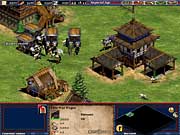
The most immediate new feature of the expansion pack is the group of new civilizations, which are loosely grouped around the conquerors' theme. Unlike the Rise of Rome pack, these new civilizations are not related by geography or time period. Instead, they are historical conquerors, mighty civilizations that expanded their reach and power through conquest. The five new civilizations are the Huns, the Koreans, the Spaniards, and two civilizations from the all-new Mesoamerican tileset, the Mayans and Aztecs. All these civilizations have already been profiled in our civilization showcase features, which you can access via the previews link in the continue box to the right. Another new feature is of course the Mesoamerican tileset, which was created for the two New World civilizations. The tileset has all new graphics for all the buildings, as well as a new look for the Aztec monk. The visual detail is stunning, and the artwork is very colorful.
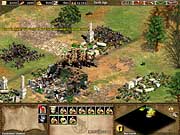
The introduction of the Mesoamerican tileset also heralds the inclusion of some new map types. There is now a jungle map type that is appropriate to the Mesoamerican theme. This map type, called the Yucatan, has lots of tropical trees, but it also replaces the sheep of the Old World with turkeys and swaps in jaguars for the wolves. It's a nice touch, but at least one detail failed to be followed up, because the turkey gatherers are still called shepherds. There is also a new snow tileset, with frozen water and snow that you can leave footprints in. Other new map types include real-world maps, which are basically maps based on the geography of real places, such as Mexico, Britain, Europe, and Japan.
Gameplay Improvements
The enhancements don't end with the new maps. There are also new game types in multiplayer mode: King of the Hill, Wonder Race, and Defend the Wonder. In King of the Hill, there is a single monument on the map that you must control for a given period of time in order to win. Thus, intense battles will rage across the monument as all players try to plant their troops over the monument for the requisite time period. The Wonder Race is a completely peaceful game. Everyone is allied, so there is no fighting. You win by being the first to build a Wonder. In addition, there are no walls and siege weapons, as the object is absolutely peaceful. The last new game type, Defend the Wonder, is the exact opposite type of game. Here, you control a Wonder that is defended by a huge, pre-built defensive network. You can of course build more defenses, but all other players will be gunning for you. They win if they destroy the Wonder, while you win if you can hold them off.

An oft-requested fix that the Conquerors finally provides is farm queuing, which has been somewhat addressed. Now, you can queue farm replenishment at the mill. There is now a button at the mill that you can click that queues up a new farm to be built if one runs out in the field. In theory, this sounds great, but in practice, it doesn't always get rid of the necessary farm micromanagement. That's because when you queue up a farm replacement, resources are deducted immediately from your stockpile. If you queue lots of farms, which you want to do to really take advantage of this feature, then you'll need to dip deep into your wood reserves. However, if you expand and establish a military complex, you won't be able to spare the wood. So during your early expansion in the Feudal and Castle Ages, you won't be able to use the farm queuing as much as you might like unless you overcompensate in wood harvesting. In addition, the farm queuing button has to be clicked before a farm runs out. If you haven't clicked this button yet, and you see a farm run out, you can't replenish it by clicking that button. The button works only before the farm runs out, not after. You still have to select the farmer and then right-click on the wasted farm. It would have been nice if Ensemble had let the farm queuing button double as an after-the-fact reseeding command for all farmers.
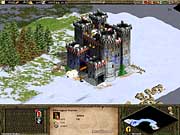
Among the other improvements are smart villagers and smart siege weapons. Now, villagers will automatically harvest resources once they finish building a resource center. If your villagers, for example, build a lumber camp near a forest, they'll immediately begin chopping wood when they finish, rather thanwaiting for you to command them to do so. Siege weapons no longer fire blindly at the enemy if their splash damage would also damage your troops. The default auto-fire engages only if your troops don't get caught in the blast.
Other enhancements to the game include being able to command allied computer opponents to give you tribute, attack your enemies, and build certain structures; make ships move in formation as land units do; and offer difficulty settings immediately upon starting a campaign.
New Units
One huge draw for Age II fans will be the new units. Each new civilization has a unique unit, which has already been detailed in our civilization showcase. To recap, the Aztecs gain the jaguar warrior, an anti-infantry infantry unit; the Mayans gain the plumed archer, a more powerful, short-ranged archer; the Huns gain the tarkan, a strong anti-building light cavalry; the Koreans get the war wagon, a heavy cavalry archer unit, and the turtle ship, a floating dreadnought; while the Spaniards get the conquistador, a mounted hand cannoneer, and the missionary, a specialized monk unit.
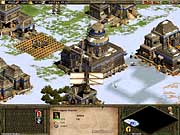
In addition to these unique units, a few non-uniques are being introduced. Here is a list with a brief description.
Eagle warrior: This is a fast infantry unit that replaces scout cavalry for the Mesoamerican civilizations. Neither the Aztecs nor the Mayans can build horse units. Thus, the eagle warrior, built at the barracks starting in the Castle Age, fills the niche left by the scout. It is fast and resistant to conversion. Aztec and Mayan players begin play with an eagle warrior rather than a scout cavalry.
Halberdier: In Age II, there were only two troops in the spearman line, the spearman and the pikeman. The Conquerors adds a third and final unit in that line, the halberdier. It is a better anti-cavalry unit that is researched in the Imperial Age.
Hussar: The hussar continues the light cavalry line of mounted units. This unit is a better light cavalry and is stronger, but it still retains the bonus against monks and the resistance to conversion. It is built in the Imperial Age.

Petard: This interesting unit is built at the castle and is basically a suicide bomber. The petard is a weak ground unit that runs madly at its target and then explodes with great force. It is excellent for destroying buildings, but ineffective against regular units. It is available in the Castle Age.
In addition to these new units, several old units have undergone minor changes. Cavalry archers and heavy cavalry archers are now much better, while camels move faster. The bombard cannon and hand cannoneer no longer have to be researched first, and they also have better bonuses against siege weapons and infantry, respectively. All light cavalry now have a bonus against monks, while the mangonel line moves and fires faster. Many unique units too, such as the samurai, huskarl, and woad raider, have been improved. The changes are significant, and they seem to make the existing units even more balanced than they were before.
New Technologies
Along with the new units come new technologies that enhance the core strengths of the existing civilizations and also shore up their weaknesses.
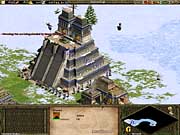
Most of the new technologies come from the monastery. There is herbal medicine, which makes units heal four times as fast when they are garrisoned in buildings. Heresy is a very powerful technology that kills your unit if it gets converted, rather than letting it switch sides. Theocracy lets your monks convert as a group, and when the targeted unit does get converted, it depletes only one monk's faith rating, rather than depleting the whole groups'.
The archery range also includes a few new technologies: thumb ring, a Castle Age technology that increases the fire rate and accuracy of archers, and parthian tactics, an Imperial Age tech that adds more armor to archers. Two other new technologies are bloodlines, which gives all mounted units +20 hit points, and caravan, which makes trade carts and cogs faster, and thus improves their gold production.
All civilizations also get a unique technology.
Aztecs: Garland Wars. This technology gives all Aztec units a +4 attack bonus.
Koreans: Shinkichon. This technology increases the range of mangonels and onagers by two.
Huns: Atheism. This unique tech adds a hundred years to all wonder and relic victories for all players; thus, it takes longer to win with this tech, and the Hun player has more time to respond.
Mayans: El Dorado. This technology gives the Mayans' eagle warriors +40 hit points.
Spaniards: Supremacy. This tech gives villagers better armor and hit points, letting them survive longer in enemy territories. With this tech, Spanish villagers can build in enemy camps.
Britons: Yeomen. This technology adds another +1 to all foot archers' range and a +2 to Briton tower attacks.
Byzantines: Logistica. With this technology, the Byzantine unique unit, the cataphract, causes trample damage just like elephants, harming adjacent units when it attacks.
Celts: Furor Celtica. All Celtic siege weapons get 50 percent more hit points with this technology.
Chinese: Rocketry. This tech makes Chinese ranged firepower even stronger. Chukonu gain +2 to attack and scorpions get +4 to their attack.
Franks: Bearded Axe. With this tech, throwing axemen gets +1 to their range.
Goths: Goths have two unique technologies: Anarchy and Perfusion. Anarchy lets Goths build huskarls at barracks, while Perfusion makes all barracks units build 50 percent faster.

Japanese: Kataparuto. With this technology, Japanese become better siege attackers, as their trebuchets fire faster and pack and unpack faster.
Mongols: Drill. Strangely, the Mongolian technology improves their siege weaponry, making all siege units except the trebuchet move 50 percent faster.
Persians: Mahouts. This technology makes war elephants move 30 percent faster.
Saracens: Zealotry. With Zealotry, Saracen camels and mamelukes get +30 hit points.
Teutons: Crenellations. The legendary Teuton defenses get even better with this technology. Castles get +3 range and garrisoned infantry add to tower attacks just as villagers would.
Turks: Artillery. Bombard towers, bombard cannons, and cannon galleons get +2 range with this technology.
Vikings: Berserkergang. The berserkers get even better with this tech, as their regeneration is now even faster.
Age of Empires II: The Conquerors definitely has a lot of new features, with new campaigns, new civilizations, new units, and new technologies. While Age II might have been overwhelming to some players in its complexity, there is no doubt it was deep and challenging. With the expansion, this complex gameplay gets even better. In a few weeks time, we'll all be able to test these new civilizations and new strategies in the age of conquerors.
Got a news tip or want to contact us directly? Email news@gamespot.com
Join the conversation